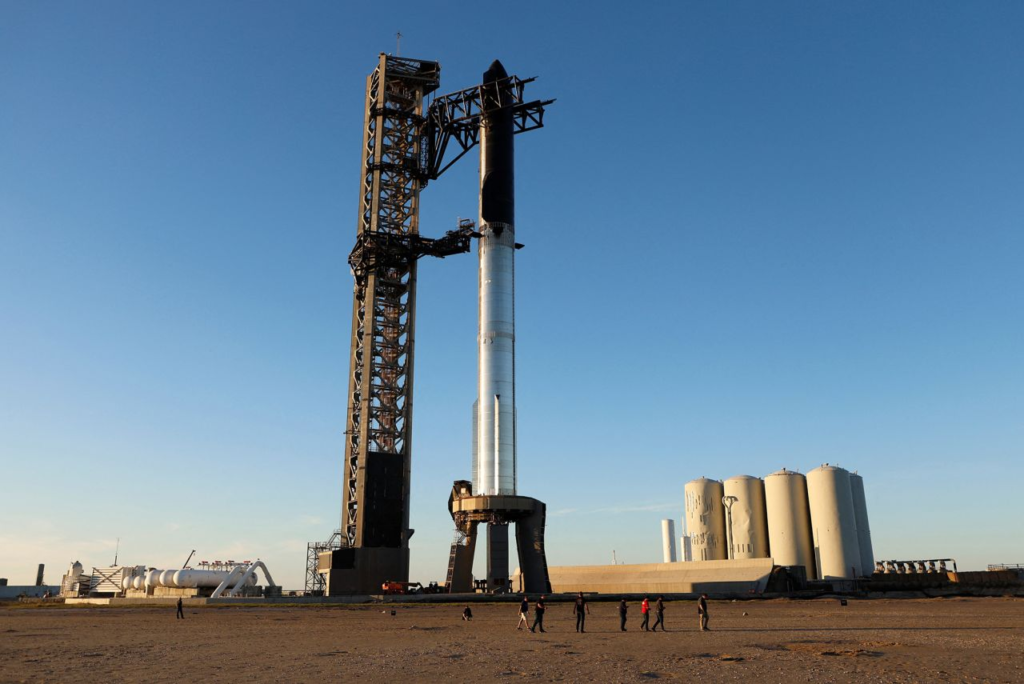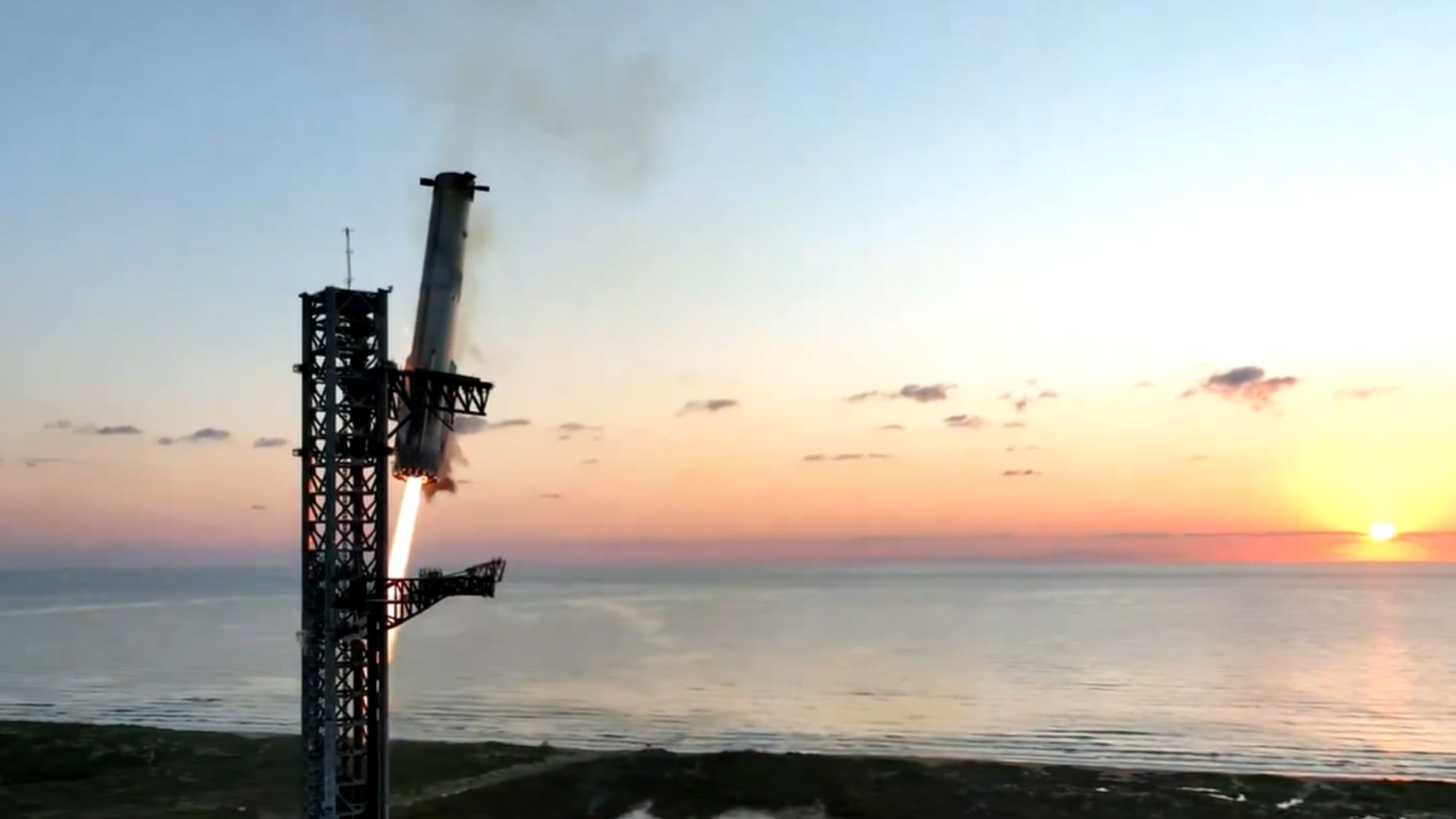In a groundbreaking event on Sunday, SpaceX achieved a major milestone in its ambitious pursuit of reusable space technology.
The company successfully caught the massive booster stage of its Starship rocket using a pair of robotic arms in a spectacle that captured the attention of astronauts, engineers, and space enthusiasts around the world.
This marked a key step toward realizing SpaceX’s long-term goal of making space travel more affordable, efficient, and accessible.
A Historic Feat: Catching the Super Heavy Booster
The launch took place at SpaceX’s Boca Chica starbase in southern Texas at 7:25 a.m. local time, with the fifth test flight of the Starship rocket. As the rocket’s Super Heavy booster, towering at 71 meters (233 feet), separated from the upper stage at an altitude of 40 miles (65 kilometers), all eyes were on the next critical phase: its controlled descent back to Earth.
Unlike previous missions, where boosters were either expended or recovered through ocean landings, this time SpaceX aimed for something revolutionary.
Read : SpaceX Mechazilla Catches Starship Booster Mid-Air – WATCH
SpaceX engineers had equipped the booster with three Raptor engines designed to reignite during descent, helping it slow down and guide itself back to the launch tower.
Read : Gopi Thotakura : 1st Indian Goes To Space As Tourist On Jeff Bezos’ Blue Origin Flight
The real test came when the booster was caught mid-air by the towering robotic arms, playfully named “chopsticks,” attached to the launch tower structure known as “mechazilla.” These arms gently grappled the descending booster and secured it back at the launch site.
The scene was nothing short of awe-inspiring. As the booster’s engines fired to slow its rapid descent, the crowd at SpaceX headquarters and online watched with bated breath. When the arms successfully caught the booster and held it fast, SpaceX employees erupted into cheers and applause. It was a moment of triumph, marking the first time that the company had ever attempted and succeeded in such a daring maneuver.
Dan Huot, SpaceX’s communications manager, could barely contain his excitement, exclaiming, “Are you kidding me? What we just saw, that looked like magic.” Kate Tice, a quality systems engineer at SpaceX, echoed his sentiment, calling it “a day for the engineering history books.”
Advancing Reusability: The Key to Mars and Beyond
This achievement is more than just a technical success—it represents a critical step in SpaceX’s broader mission to develop fully reusable rockets. Reusability is seen as a game-changing element in reducing the cost of space travel and making missions to the Moon, Mars, and beyond more economically viable.
Elon Musk, the CEO of SpaceX, has long emphasized the importance of reusability in space exploration. By making rocket boosters, spacecraft, and other components reusable, SpaceX aims to lower the costs of launching payloads and humans into space dramatically. Instead of building new rockets for each mission, a reusable system would allow for faster turnaround times and more frequent launches.
Catching the Super Heavy booster with robotic arms eliminates the need for complex landing pads or ocean recovery missions, making it easier to refurbish and prepare the booster for future launches. This technique also allows SpaceX to push the boundaries of booster reusability further, as every part of the rocket can be more easily inspected and refurbished when it’s captured directly at the launch site.

This development aligns with SpaceX’s ultimate goal: enabling human colonization of Mars. Musk has frequently stated that he envisions a future where Starship rockets can ferry astronauts, equipment, and supplies to the Red Planet in regular intervals, creating a self-sustaining colony.
To achieve this vision, making rockets that can be launched and reused frequently and reliably is essential. The successful capture of the booster is a major leap toward realizing that vision.
Former astronaut Chris Hadfield praised the achievement, saying, “There was an enormous step forward in human capability today. Makes me even more excited for our collective future. Congratulations to all at SpaceX!”
A Successful Test Flight with a Few Surprises
While the booster capture was the highlight of the day, the rest of the test flight also showcased the advancements SpaceX has made with the Starship rocket. After the booster separated at 40 miles above Earth, the upper stage continued its journey, reaching an altitude of nearly 90 miles. Traveling at a speed of 17,000 mph, the upper stage completed a partial orbit around the planet before re-entering the atmosphere.
The descent of the upper stage was particularly noteworthy for the improvements SpaceX has made to Starship’s heat-shielding system. During the June test flight, the Starship’s heat shield suffered significant damage, complicating its re-entry. However, for this flight, SpaceX made enhancements to the 18,000 heat-shielding tiles that protect the rocket from the intense heat of re-entry.
As the Starship re-entered Earth’s atmosphere, onboard cameras captured the stunning visuals of a smooth, pinkish-purple plasma enveloping the ship’s Earth-facing side.
The improvements to the heat shield were evident, as the spacecraft appeared more intact compared to the June test. Once Starship had re-entered, it reignited one of its six engines to position itself upright for the planned ocean landing.

The landing took place off the coast of Australia, where the Starship touched down in nighttime waters. However, the test flight concluded with an unexpected turn of events. After landing upright, the Starship rocket toppled onto its side. Shortly afterward, a camera feed from a nearby vessel captured the rocket exploding into a large fireball.
It remains unclear whether the explosion was a planned, controlled detonation or the result of a fuel leak or other malfunction. Despite the fiery conclusion, Musk and SpaceX officials emphasized that the ship landed “precisely on target.”
Even with this surprise ending, the overall mission was deemed a success. The primary objectives of the flight—testing Starship’s heat shield, re-entry systems, and landing capabilities—were largely met, and the successful capture of the booster demonstrated the viability of the new recovery technique.
The Future of Starship and Space Travel
The successful capture of the Starship booster represents a major milestone not only for SpaceX but for the broader space industry. With this achievement, SpaceX has taken a significant step toward its goal of making space travel more routine, cost-effective, and sustainable.
Looking forward, SpaceX plans to continue refining the Starship system in preparation for future missions. The company has already secured contracts with NASA to use Starship as part of the Artemis program, which aims to return humans to the Moon and establish a sustainable presence there. Starship will also be critical to SpaceX’s plans for interplanetary travel, with Mars being the ultimate destination.

In addition to human space exploration, the reusability of the Starship system has enormous implications for satellite launches, cargo missions, and other space-based activities. By dramatically lowering the cost of launches, SpaceX can make space more accessible to a wide range of industries, from telecommunications to scientific research.
For now, SpaceX continues to push the boundaries of what is possible in space technology. The successful capture of the Starship booster is a testament to the company’s innovative spirit and relentless drive to turn science fiction into reality. As Musk and his team forge ahead, the world watches in anticipation of the next leap forward in humanity’s journey into the stars.

